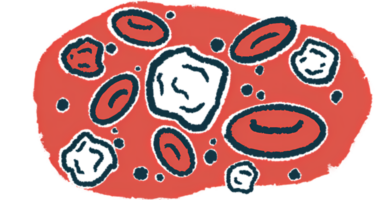Need to Know: What Is the ‘Barber Chair Phenomenon’?

Editor’s note: “Need to Know” is a series inspired by common forum questions and comments from readers. Have a comment or question about MS? Visit our forum.
This week’s question is inspired by the forum topic “Lhermitte’s Sign…” from May 4, 2018.
What is the barber chair phenomenon?
This vernacular expression describes a brief electrical sensation that “buzzes” from the base of the neck into the arms and limbs when one flexes the neck to move the chin to the chest. This posture is commonly assumed while getting one’s hair cut, hence the name.
Its more clinical name is Lhermitte’s sign. French neurologist Jean Lhermitte (pronounced LARE-meet) made the connection between the phenomenon and MS patients in 1924. However, researchers Pierre Marie and Chatelin were the first to describe it in 1917.
Lhermitte’s sign: A pain in the neck
Lhermitte’s sign — which is actually not a sign, but a symptom — is not unique to MS.
People who experience this sensation, described as one of the pain syndromes of MS, might have any of the following conditions instead:
- Tumors
- Spinal trauma
- Cervical disc herniation
- Spondylosis
- Myelopathy
- Vitamin B12 deficiency
- Transverse myelitis
- Behçet’s disease
- Arnold-Chiari malformation or other compression of the cervical spinal cord
People undergoing chemotherapy or radiation for cancer may experience Lhermitte’s. Use of certain medications, or withdrawal from certain medications, can also bring on the symptom.
Still, about 16 percent of people with MS experience this classic form of MS nerve pain. The sign can be traced back to lesions of the cervical spinal cord or lower brainstem, and may also be the product of demyelination in other regions of the brain.
The Multiple Sclerosis Trust says that, “The likelihood of experiencing Lhermitte’s sign did not correspond to someone’s age, gender, level of disability, as judged by their EDSS score, or how long they had been diagnosed.”
Whatever you call it, here’s what you can do about it.
Typically, the symptom is paroxysmal, meaning it’s experienced suddenly, by itself, or within a cluster of symptoms that are short-lived (a few minutes, at most). It resolves within a brief period, and most people do not have extended problems with it, though it can come and go over time.
It can be triggered by unnatural flexing of the neck, stress, fatigue, and overheating. Lhermitte’s is associated primarily with people who have MS because they commonly experience each of these triggers.
Obviously, avoiding triggers is one way to prevent a repeat of the barber chair phenomenon. Some physical adaptations may also be helpful. The Multiple Sclerosis Trust recommends:
- Using a support collar to minimize neck movement
- Learning postural improvements from a physiotherapist
- Practicing muscle relaxation techniques, deep-breathing exercises, or mild stretches
- Applying a transcutaneous electrical nerve stimulation (TENS) unit
If you encounter this unpleasant symptom, and if the pain is severe and frequent, ask your doctor to consider treating it with medication. If treatment doesn’t help, you may be asked to undergo other tests to rule out other causes for this painful phenomenon.
Do you experience barber chair phenomenon? What are your triggers? Have you found any nonpharmaceutical approaches that bring relief, or do you just wait out these electrical jolts? Post your replies in the comments below or at the original “Lhermitte’s Sign…” forum entry.
***
Note: Multiple Sclerosis News Today is strictly a news and information website about the disease. It does not provide medical advice, diagnosis, or treatment. This content is not intended to be a substitute for professional medical advice, diagnosis, or treatment. Always seek the advice of your physician or other qualified health provider with any questions you may have regarding a medical condition. Never disregard professional medical advice or delay in seeking it because of something you have read on this website. The opinions expressed in this column are not those of Multiple Sclerosis News Today or its parent company, Bionews Services, and are intended to spark discussion about issues pertaining to multiple sclerosis.







Samuel F Hunter, MD, PhD
The best treatment is carbamazepine or related medications.
Tamara Sellman
Thank you for sharing your recommendations!
Tamara
Penny Sheppard
I have experienced a "buzzing" sensation in my groin area, upper inner thighs and lower abdomin (similar to the buzzing of a cell phone if it were in my pocket) could this be the same thing?
Haslie
Yes, Vibrating and buzzing sensation.
Tamara Sellman
Hi Penny
I'm not a doctor but what you describe could be neurological symptoms that are typical to MS. Lhermitte's is limited to the neck area, so it might not be that exactly, but it could still be general dysesthesia or paresthesia caused by nerve damage.
Tamara
Liz
I experienced this one day last year, when I got up from the computer, bent my head down, and all hell broke loose: pulling from my head to my toes, my right side seized, and I couldn’t walk. I thought I was having a stroke. Then I began experiencing a disturbing buzzing in my right groin area that prohibited me from sitting. 5 episodes (and 5 hospitalizations) later, I was diagnosed with cervical spondylosis and MS, and prescribed Tegretol and Gabapentin, and I haven’t had an event since then. I also see a chiropractor once a week.
Tamara Sellman
Thank you for sharing the details of your story, Liz, this will be very helpful for others undergoing similarly bizarre physical sensations. Glad you have found some relief!
Tamara
Sanora
For 8 years I lived with the 'buzz' which extended down my right arm whenever head was tipped downwards. One day my entire right arm went numb (no buzz) and for two months had to use my left arm to turn key in the ignition and shift car into gear, signed documents with an 'X'. When the relapse ended, the buzz didn't return.
Tamara Sellman
Yes, that annoying buzz! Glad you're in remission and now buzz free!
Tamara
Bomani
I have been dealing with Lhermitte's since I first got diagnosed with MS 3 years ago. at first the shock was so bad that it would stop me dead in my tracks. over time my legs began to weaken from the shocks over time. I ended up having to use a walking stick to move around for a few weeks. the shocks have become less intense over time, however, it hasn't fully went away. I feel it mostly when I'm working out.
Julie
I started having this buzzing about 8 months ago. No other symptoms but as I have had a radical cystectomy 23 years ago, I was told to watch my B12. I increased my B12 and had blood tests which confirms my B12 level is okay. I determined that it seems to be Lhermitte's sign and it continues to date. Every 2 or 3 weeks, I still get 2 or 3 buzzes and then, it goes away. Recently I went 6 weeks without Lhermitte but today and yesterday, I experienced it once again. I think it is coming from my neck. I am 70 years old, active and in fairly good health.